The rebirth of monumental sculptureThe seven reliefs, pictured below, have been relocated to the wall of the ambulatory. These reliefs include one of Christ, four of angels, and two of Apostles. Scholars have speculated on their original location--perhaps part of shrine honoring St. Sernin in the crypt of this church, perhaps part of a choir screen, perhaps part of a doorway.
What all agree on is their significance--a rebirth of monumental sculpture, which began in the Romanesque period in churches in France. Figure sculpture like this probably was influenced by Ottonian ivory carvings or metalwork, seen especially in the low relief and essentially linear style.
Christ in Majesty--4' 2' HChrist, in a mandorla with engraved patterns around its circuit, raises his right hand in blessing with his left hand on a book inscribed with "Pax vobis" (Peace be with you). He is seated on a throne with an incised pattern and on a pillow with decorative braid.
|
The four Evangelists symbols at the corners The eagle (St. John) and man/angel (St. Matthew) are located at the top left and right while the ox (St. Luke) and lion (St. Mark) are located at the bottom corners. These symbols, too, have linear patterns in their wings and bodies. |
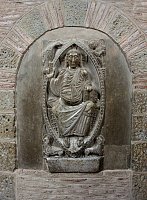
|
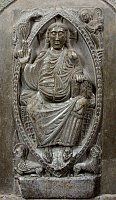
|
| |
|
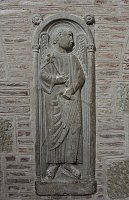
|
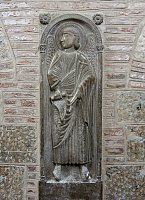
|
Two angels holding scrollsInscriptions on the architectural arches identify these angels as seraphim (center) and cherubim (left). Both hold scrolls with the word "Sanctus" repeated three times ("Holy, holy, holy"). All of the angels are in profile, which may have meant they were designed to face toward a more important figure. In the ambulatory, these two are placed flanking Christ. |
| |
|
Two Apostles holding booksThe sculptor emphasizes the contour or silhouette in all these reliefs; linear patterns predominate--the cap of curly hair or the double lines for folds.
|
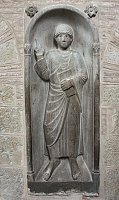
|
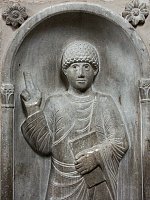
|

|
| |
|
Two angels, both holding cross-tipped staffs |
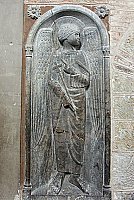
|
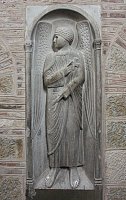
|
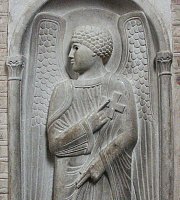
|


 Go to Saint-Sernin Index.
Go to Saint-Sernin Index. Click here to return to index of art historical sites.
Click here to return to index of art historical sites.
 Click here to return to index of artists and architects.
Click here to return to index of artists and architects.
 Click here to return to chronological index.
Click here to return to chronological index.
 Click here to see the home page of Bluffton University.
Click here to see the home page of Bluffton University.

